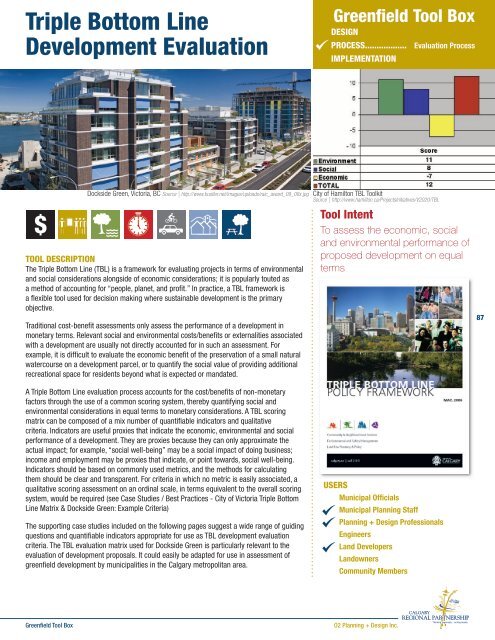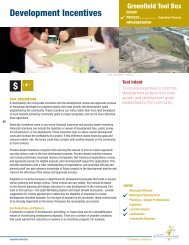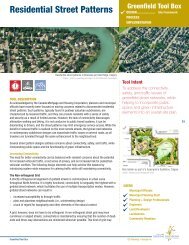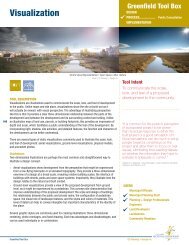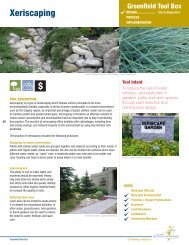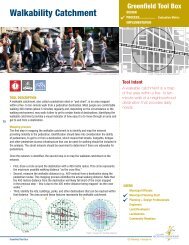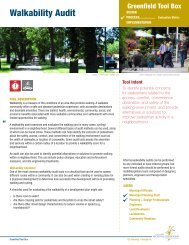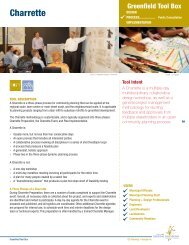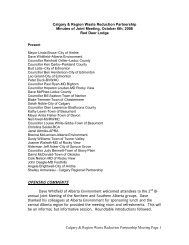Triple Bottom Line Development Evaluation - The Greenfield Tool Box
Triple Bottom Line Development Evaluation - The Greenfield Tool Box
Triple Bottom Line Development Evaluation - The Greenfield Tool Box
You also want an ePaper? Increase the reach of your titles
YUMPU automatically turns print PDFs into web optimized ePapers that Google loves.
<strong>Triple</strong> <strong>Bottom</strong> <strong>Line</strong><strong>Development</strong> <strong>Evaluation</strong><strong>Greenfield</strong> <strong>Tool</strong> <strong>Box</strong>DESIGNPROCESS.................. <strong>Evaluation</strong> ProcessIMPLEMENTATIONDockside Green, Victoria, BC Source | http://www.bustler.net/images/uploads/raic_award_09_08x.jpgTOOL DESCRIPTION<strong>The</strong> <strong>Triple</strong> <strong>Bottom</strong> <strong>Line</strong> (TBL) is a framework for evaluating projects in terms of environmentaland social considerations alongside of economic considerations; it is popularly touted asa method of accounting for “people, planet, and profit.” In practice, a TBL framework isa flexible tool used for decision making where sustainable development is the primaryobjective.Traditional cost-benefit assessments only assess the performance of a development inmonetary terms. Relevant social and environmental costs/benefits or externalities associatedwith a development are usually not directly accounted for in such an assessment. Forexample, it is difficult to evaluate the economic benefit of the preservation of a small naturalwatercourse on a development parcel, or to quantify the social value of providing additionalrecreational space for residents beyond what is expected or mandated.City of Hamilton TBL <strong>Tool</strong>kitSource | http://www.hamilton.ca/ProjectsInitiatives/V2020/TBL<strong>Tool</strong> IntentTo assess the economic, socialand environmental performance ofproposed development on equalterms87A <strong>Triple</strong> <strong>Bottom</strong> <strong>Line</strong> evaluation process accounts for the cost/benefits of non-monetaryfactors through the use of a common scoring system, thereby quantifying social andenvironmental considerations in equal terms to monetary considerations. A TBL scoringmatrix can be composed of a mix number of quantifiable indicators and qualitativecriteria. Indicators are useful proxies that indicate the economic, environmental and socialperformance of a development. <strong>The</strong>y are proxies because they can only approximate theactual impact; for example, “social well-being” may be a social impact of doing business;income and employment may be proxies that indicate, or point towards, social well-being.Indicators should be based on commonly used metrics, and the methods for calculatingthem should be clear and transparent. For criteria in which no metric is easily associated, aqualitative scoring assessment on an ordinal scale, in terms equivalent to the overall scoringsystem, would be required (see Case Studies / Best Practices - City of Victoria <strong>Triple</strong> <strong>Bottom</strong><strong>Line</strong> Matrix & Dockside Green: Example Criteria)<strong>The</strong> supporting case studies included on the following pages suggest a wide range of guidingquestions and quantifiable indicators appropriate for use as TBL development evaluationcriteria. <strong>The</strong> TBL evaluation matrix used for Dockside Green is particularly relevant to theevaluation of development proposals. It could easily be adapted for use in assessment ofgreenfield development by municipalities in the Calgary metropolitan area.USERSMunicipal OfficialsMunicipal Planning StaffPlanning + Design ProfessionalsEngineersLand DevelopersLandownersCommunity Members<strong>Greenfield</strong> <strong>Tool</strong> <strong>Box</strong>O2 Planning + Design Inc.
<strong>Triple</strong> <strong>Bottom</strong> <strong>Line</strong> <strong>Development</strong> EvalutionWHEN IN THE PROCESS IT IS USED?A TBL evaluation can have two important roles in the development process: supportingproposal evaluation, and communicating the performance of the development to the publicduring consultation.Proposal evaluationA TBL evaluation can be used in the review of development proposals to ensure that criteriaare consistently applied through a transparent process. A preliminary evaluation by municipalofficials and staff can help developers to understand expectations before the application,review, and approvals process has formally started. It can also be used directly duringa review as a basis for approving, conditionally approving, or disapproving a proposal. Ifused throughout the evaluation process, the TBL evaluation can help to educate both thedevelopment community and planning staff about how to work together effectively to meetcommunity goals.Public consultationTBL criteria are effective in communicating the performance of a development to the publicin terms of community goals. It facilitates informed conversation about the overlap betweencommunity goals and potential project outcomes. This can work to educate the public and thedevelopment community about mutual interests, and can help to reduce potential conflictsand resulting delays.CASE STUDIES | BEST PRACTICESCity of Victoria <strong>Triple</strong> <strong>Bottom</strong> <strong>Line</strong> Matrix &Dockside Green: Example Criteria3.4 Urban Design - Circulation› Social:How does the circulation encourage connectedness, a senseof place and community, both within the dockside lands andbetween the community of Victoria West and Victoria?› Economic:Are the modes of transportation sustainable to maintain/service, both now and in the long term?› Environmental:To what extent does the proposal encourage alternate modesof transportation?88CASE STUDIES | BEST PRACTICESCity of Victoria <strong>Triple</strong> <strong>Bottom</strong> <strong>Line</strong> Matrix & Dockside Green<strong>The</strong> City of Victoria used a <strong>Triple</strong> <strong>Bottom</strong> <strong>Line</strong> decision matrix to evaluate proposals fordevelopment of Dockside Green, an industrial waterfront redevelopment project. A number ofcriteria were employed (see example at right). This included an evaluation of the developer’sfinancial capacity for the project, knowledge to deal with the contaminated land found on thesite, a commitment to at least LEED silver standard development, and commitment to partnerwith local community associations in the design of the site. <strong>The</strong> use of a TBL evaluationprocess allowed potential developers to discount environmental and social benefits from theprice they were prepared to pay for the land; this allowed developers genuinely interestedin sustainable development being able to compete on an even footing with more traditionalsingle bottom line developers. Despite the increased complexity of the proposal evaluationprocess, the selection of the winning developer team of VanCity and Windmill <strong>Development</strong>occurred in a shorter time span than typical for a project of such a scale.Above + Left: Dockside Green Synergy Design ProposalCredit | Busby Perkins+Will Architects (Vancouver, BC)Source | http://www.raic.org/honours_and_awards/awards_raic_awards/2009recipients/dockside_e.htm<strong>Greenfield</strong> <strong>Tool</strong> <strong>Box</strong>O2 Planning + Design Inc.
<strong>Triple</strong> <strong>Bottom</strong> <strong>Line</strong> <strong>Development</strong> EvalutionHamilton <strong>Triple</strong> <strong>Bottom</strong> <strong>Line</strong> <strong>Evaluation</strong> <strong>Tool</strong>kit<strong>The</strong> City of Hamilton utilizes TBL as a framework for assessing social, economic andenvironmental considerations of different development options. Specific criteria weredeveloped from consultation with local communities, which identify many different prioritiesthat typically include social economic and environmental elements. It uses a matrix/scorecardapproach that allows for ranking both qualitative and quantitative evaluation criteria, andis applied in a multi-scale process. A “long list” of development options are first evaluatedusing broad-scale TBL evaluation criteria. Once narrowed down, a detail TBL evaluation isperformed to identify a preferred development option.Importantly, the implementation of this TBL framework in Hamilton was supported by a seriesof training workshops. <strong>The</strong>se were intended to build the capacity of participants to not onlyuse the TBL computer application, but to set the frame of mind required to approach andsolve problems with economic, social, and environmental considerations.Calgary <strong>Triple</strong> <strong>Bottom</strong> <strong>Line</strong> Policy FrameworkCalgary’s <strong>Triple</strong> <strong>Bottom</strong> <strong>Line</strong> Policy Framework is intended to help Council and Administrationmake decisions using an integrated approach to evaluate a complex set of considerationsby helping to identify a wide range of possible impacts and consider issues they might notordinarily think about. <strong>The</strong> framework is a Council-approved summary of existing City policiesregarding the economy, environment and society. Over 350 policy statements have beensummarized into more than 20 themes under the headings Economic, Social, Environmentand Integrated Policies (Smart Growth). A complete TBL analysis requires a review of theproject or initiative against each of the 23 policy themes included in the framework. A seriesof guiding questions are included under each policy theme to prompt broad considerations ofthe implications of a given project.Unlike the Hamilton or Victoria (Dockside Green) evaluation processes, the Calgary TBL policyframework is just that: a framework. <strong>The</strong>re is no prescribed scoring system. Conceivably, thispolicy framework could be adapted to a scoring matrix by any municipality within the region,modified as needed to suit local priorities.City of Hamilton TBL Evalution <strong>Tool</strong>kitSource | http://www.hamilton.ca/NR/rdonlyres/A6062B08-8FBD-4091-ADB2-723C4E696033/0/1TBLinHamilton.pdf89RELATED TOOLSSmart Growth ScorecardsLEED-ND Rating System<strong>Development</strong> IncentivesLife Cycle CostingADDITIONAL RESOURCES<strong>Triple</strong> <strong>Bottom</strong> <strong>Line</strong> in Practice: From Dockside to Dockside Green(http://www.crcresearch.org/case-studies/case-studies-sustainable-infrastructure/land-use-planning/triple-bottom-line-practice-f)City of Victoria Dockside Green RFP: <strong>Triple</strong> <strong>Bottom</strong> <strong>Line</strong> Criteria / <strong>Evaluation</strong> Criteria (center Appendix A)(http://www.victoria.ca/cityhall/pdfs/currentprojects_dockside_rfp100904.pdf)City of Hamilton <strong>Triple</strong> <strong>Bottom</strong> <strong>Line</strong> <strong>Evaluation</strong> <strong>Tool</strong>kit(http://www.hamilton.ca/ProjectsInitiatives/V2020/TBL/Information+Provided+to+Mayors+Advisory+Group.htm)<strong>The</strong> University of Sydney <strong>Triple</strong> <strong>Bottom</strong> <strong>Line</strong> Reporting / Sustainability Reporting Framework(http://www.isa.org.usyd.edu.au/research/tbl.shtml)<strong>The</strong> City of Calgary <strong>Triple</strong> <strong>Bottom</strong> <strong>Line</strong> Policy Framework(http://www.calgary.ca/UEP/ESM/Documents/ESM-Documents/tbl_policy_framework.pdf)<strong>Greenfield</strong> <strong>Tool</strong> <strong>Box</strong>O2 Planning + Design Inc.


